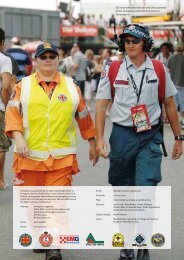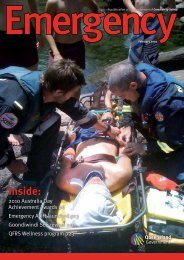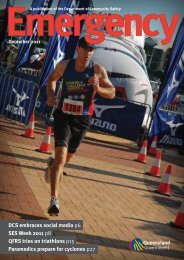Photo by Michael Marston - Department of Emergency Services ...
Photo by Michael Marston - Department of Emergency Services ...
Photo by Michael Marston - Department of Emergency Services ...
Create successful ePaper yourself
Turn your PDF publications into a flip-book with our unique Google optimized e-Paper software.
Clinical challenge<br />
By Drew Hebbron, Acting Senior Clinical Educator<br />
The time is 08:00 and you<br />
have been dispatched to the<br />
main platform at Central Station<br />
in Brisbane for a female patient<br />
complaining <strong>of</strong> lethargy, fatigue and<br />
light-headedness.<br />
On arrival at Central, it is apparent<br />
you have arrived mid-peak hour with<br />
thousands <strong>of</strong> commuters making<br />
their way to and from the station.<br />
Your patient is found beside the<br />
platform servicing the north-eastern<br />
area <strong>of</strong> Brisbane with a Queensland<br />
Rail Security Officer in attendance.<br />
The Security Officer states the<br />
patient was observed trying to board<br />
the train with her bags, walking with<br />
an unsteady gait, having obvious<br />
difficulty in breathing and pr<strong>of</strong>use<br />
diaphoresis.<br />
She was assisted <strong>by</strong> security to a<br />
bench seat where she is presently<br />
located.<br />
The patient is female, mid 20s and<br />
appears to be <strong>of</strong> Asian descent.<br />
She is only able to communicate<br />
in broken English and has obvious<br />
extreme dyspnoea. She also has a<br />
fairly constant productive cough.<br />
Upon questioning, the patient is<br />
able to indicate she has felt unwell<br />
for several days and indicates<br />
her condition has been gradually<br />
getting worse.<br />
She states further that she has<br />
experienced diahorrea for the<br />
last five days.<br />
When asked about seeking medical<br />
aid, the patient states she has not.<br />
You are able to ascertain she has<br />
been here visiting family from her<br />
homeland <strong>of</strong> Indonesia for the<br />
past eight days and is returning<br />
home today.<br />
Her usual occupation at home is<br />
working on her family’s farm. She<br />
states she began feeling unwell<br />
a couple <strong>of</strong> days after arriving in<br />
Brisbane.<br />
She states she came from a hot<br />
humid climate into Brisbane’s winter.<br />
She states she has not been around<br />
any other people displaying signs <strong>of</strong><br />
illness and says she has no allergies<br />
and is currently on no medication.<br />
Her VSS is as follows:<br />
Pulse – 160<br />
BP – 110/60<br />
RR 50 – shallow/rapid<br />
SpO2 – 95% RA<br />
ECG – Sinus Tachy @ 160BPM<br />
BSL – 5.4mmol<br />
Chest Auscultation – Congestion and<br />
“wet” chest sounds with crackles<br />
widespread bi-laterally<br />
GCS – 14<br />
Temp – 39.5C<br />
General Observations – patient is<br />
thin, and short in stature, appears<br />
generally pale and diaphoretic.<br />
The patient complains further <strong>of</strong><br />
general aches and pains shortly<br />
before she appears to lose balance<br />
on her seat and falls unconscious.<br />
Her respirations, while still present,<br />
appear to be becoming more and<br />
more laboured.<br />
A head to toe examination reveals<br />
nothing significant.<br />
Oxygen therapy has no effect and<br />
your patient’s condition remains<br />
unchanged en-route to hospital.<br />
Questions<br />
1. What is your provisional<br />
diagnosis for this patient?<br />
2. Is there anything about this<br />
patient’s condition that strikes<br />
you as unusual?<br />
3. What procedures/treatment<br />
regimes would you instigate?<br />
September<br />
Challenge<br />
answers<br />
By David Couper, QAS Paramedic<br />
What is the cause <strong>of</strong> this<br />
patient’s presentation?<br />
This injury is called wrist<br />
neuropathy or handlebar palsy.<br />
What is the aeitology <strong>of</strong> that<br />
cause?<br />
Wrist neuropathy is the irritation<br />
and associated inflammation <strong>of</strong><br />
a nerve as it crosses the wrist<br />
joint. In this case the Ulnar<br />
nerve is affected, resulting in<br />
numbness <strong>of</strong> the small and ring<br />
finger and Median nerve with<br />
numbness <strong>of</strong> the remaining<br />
fingers and thumb.<br />
Other activities that involve<br />
repetitive movements <strong>of</strong><br />
the wrist may cause Ulnar<br />
neuropathy, such as using a<br />
computer mouse or typing. It<br />
may also occur from an injury<br />
to your elbow.<br />
Other causes <strong>of</strong> Ulnar<br />
neuropathy at or distal to the<br />
wrist (ie at Guyon canal) include:<br />
ganglionic cysts; tumours; blunt<br />
injuries with or without fracture;<br />
aberrant artery and idiopathic.<br />
What is the management <strong>of</strong><br />
this patient?<br />
Rest, consider use <strong>of</strong> a sling and<br />
referral to a physiotherapist.<br />
Document in detail all motor and<br />
sensory impairment.<br />
Most importantly, the cyclist<br />
needs to have his bike set up<br />
evaluated <strong>by</strong> a bike pr<strong>of</strong>essional.<br />
6 EMERGENCY October 2006 www.emergency.qld.gov.au






